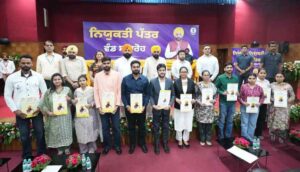Leucocyte Telomere Length is linked to obesity in pre-diabetic and Type 2 diabetic women
3 min readChandigarh, August 4, 2022: A recent study has revealed that Leucocyte Telomere Length (LTL) is linked to obesity in pre-diabetic and type 2 diabetic women. LTL is the measure most commonly used to study age-dependent shortening and disease risk in human populations. The study explored the relationship between prediabetes, truncal obesity and LTL, shortening of which, indicates faster aging and premature death. The research was conceived and designed by Dr Anoop Misra, Padma Shri, Executive Chairman and Director, Diabetes and Endocrinology, Fortis C-DOC Hospital for Diabetes and Allied Sciences, and conducted jointly by Surya Prakash Bhatt, Ravindra Mohan Pandeyand Ashish Datt Upadhyay.The findings have been recently published in the journal, BMJ Open Diabetes Research & Care.
It is already known that LTL is linked with aging and associated diseases, such as obesity, type 2 diabetes, and cardiovascular disease. This is the first study to investigate the relationship of LTL in pre-diabetic women, and specifically, the relationship of LTL with obesity is being reported in women for the first time.
Research design and method
In this cross-sectional study from July 2015 to December 2020, 1,361 women were randomly selected from North India (aged 20–60 years) who were residing there for more than 6 months. Among them, 797 pre-diabetic women (obese, 492; non-obese, 305) were enlisted and their demographic, clinical profiles and fasting blood glucose were evaluated. LTL was quantified by a quantitative Polymerase Chain Reaction (PCR), which is a laboratory technique for rapidly amplifying millions of copies of a specific segment of DNA. Along with that, the telomere length was detected from DNA samples and expressed as the mean T/S ratio (telomere repeats per single-copy gene). The study subjects were randomly designated to have an approximate representation of higher, medium and lower income groups from 41 residential areas in Delhi. Many of them were excluded on various grounds which includes the use of oral antidiabetic drugs, alcohol, tobacco, or drug abuse, any medication which could affect insulin sensitivity, those who are pregnant, severe end-organ damage or chronic diseases, malignancy and other endocrine disorders and significant liver, kidney, thyroid, or other endocrine diseases.
Key Findings:
· The study links LTL in women with abnormal fasting glycemia (pre-diabetes). The relationship of LTL with fatness, particularly in the truncal part of the body is being reported for the first time
· The average LTL was significantly shorter in obese women with pre-diabetes.
· The R-squared (R2) statistic for the multivariable linear model after adjusting for age, family income, education, and hypertension showed that LTL was inversely correlated with body mass index (BMI), waist and hip circumference, waist-hip and waist-to-height ratio, truncal skinfolds (triceps ratio, central and total skinfolds), fat mass (kg) and percentage body fat
· Besides age, obesity, and fat distribution in the truncal part of the body are major contributors to telomere shortening in women with abnormal fasting glycemia
Dr Anoop Misra, Padma Shri, Executive Chairman and Director, Diabetes and Endocrinology, Fortis C-DOC shared, “Besides age, obesity and subcutaneous adiposity (predominantly truncal) are major contributors to telomere shortening in Asian Indian women with abnormal fasting glycemia (impaired fasting glucose). This means Indian women who are excess fat over trunk and are prediabetes, may have lower longevity. It has connotation to mortality statistics of females in India as well huge implications of prevention of prediabetes.”
Lead author, Dr Surya Prakash stated; “Obesity in Indian women starts to increase in the 30-40 age group, and that is where most of the lifestyle efforts should be concentrated.”




